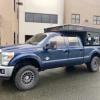I looked through this thread, and didn't see mention. I've been intrigued by Renogy's new dual-input battery chargers, that combine both a solar input and a smart alternator input. It includes a MPPT solar controller. It seems like a great combination. They have both 30A and 50A models. Also includes bluetooth interfaces.
I really like my current Victron MPPT controller, but I could really increase the highway charging with this device. Does anyone have any intel on the new Renogy devices?
Will Prowse (believable dude) reviews it here -
The downside for this device is the low input voltage, that requires all your solar panels to be in parallel, and limits you to 36 cell (160W) panels.

















